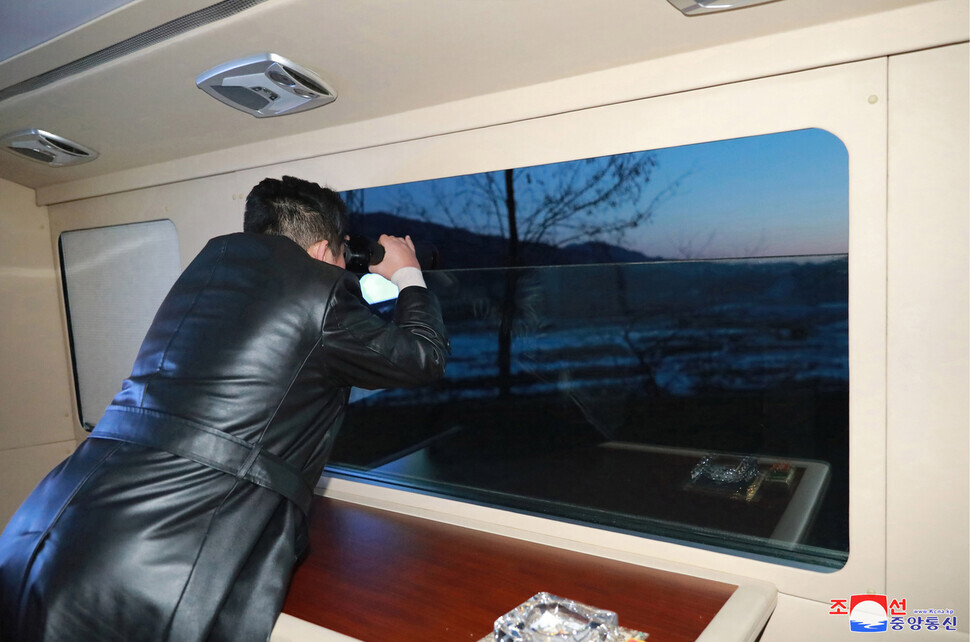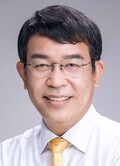hankyoreh
Links to other country sites 다른 나라 사이트 링크
[Column] Kill Chain preemptive strike? Don’t make Kim Jong-un laugh


The concept of the Kill Chain system, which is supposed to deter North Korea from launching nuclear-tipped missiles, first appeared in South Korea during the administration of President Lee Myung-bak, when the country was still in an uproar after North Korea shelled Yeonpyeong Island. The concept was cobbled together by working-level officials at the Ministry of National Defense after newly appointed Defense Minister Kim Kwan-jin instructed them to develop a response to North Korea’s nuclear program.
The crux of the Kill Chain system is its “left of launch” capability to detect preparation for a missile launch in North Korea and to take out the missile before it’s launched. The term “left of launch” derives from the fact that “preparation” appears to the left of “launch” in the typical phases of a missile attack — preparation, launch, ascent and descent. This is tied to the concept of a preemptive strike, which is supposed to suppress the enemy’s launch capabilities within 30 minutes of detection.
South Korea’s Joint Chiefs of Staff opposed the Kill Chain program at the time on the grounds that “adopting a concept that isn’t practical because of a lack of capabilities would greatly distort our fighting power.” But under pressure to come up with something to show the public, the Ministry of National Defense went ahead and announced the adoption of the system.
Since then, the South Korean military has kept refining plans to acquire that capability through reconnaissance satellites and missiles, but they’re still far from completion. The military failed to analyze any aspect of the conical hypersonic missile that North Korea fired on Jan. 5 — including the speed, flight path and warhead type.
Despite not having any technical data about the launch, Seoul downplayed North Korea’s projectile as being “a ballistic missile, not a hypersonic missile.” In apparent irritation, the North Koreans fired yet another projectile that was similar to a hypersonic missile on Tuesday. That illustrates the limitations of South Korea’s current technology.
Yoon Suk-yeol, the presidential candidate for the People Power Party, recently said that if North Korea launches a missile with a speed of Mach 5 or above, “a preemptive strike would be our only recourse” since aerial defense would be impossible at that speed.
Yoon based his remarks on the concept of the kill chain, but he’s mistaken about something. When it was developed in 2010, the kill chain was based on the assumption that most of North Korea’s missiles require liquid fuel and fixed launchers. But 12 years later, the North is quickly converting its missile force to solid-fuel missiles that can be fired from mobile launchers.
Under the leadership of Kim Jong-un, North Korea long ago abandoned the conventional approach of spending half an hour fueling missiles and then firing them from vulnerable military bases. It’s not easy for South Korean intelligence assets to determine where North Korean missiles would be launched from, and if the missiles don’t use liquid fuel — that is, if they don’t require the preparatory fueling stage — the Kill Chain is useless.
This remains true even if North Korea keeps using liquid fuel. While launching its new missile on Jan. 5, the North said it had tested a “missile fuel ampoule.” If accurate, that would make any thought of detecting North Korean missiles “left of launch” truly naïve and unrealistic.
In recent conversations, younger generals in the Joint Chiefs of Staff have told me that the system’s concept has become obsolete because the preparation phase is being eliminated from North Korean missile launches.
For such reasons, even the US is transitioning from a kill chain to the new concept of a “kill web.” This refers to a futuristic weapon system composed of hundreds of low-orbit satellite clusters, mass data transmission, and autonomous weapons that track and destroy the enemy’s missile launchers.
Before talking about launching a preemptive strike on North Korea, Yoon ought to have considered what the target of such a strike would be, what methods would be used, whether the military can make those preparations, and how effective it would be. Surely that level of due diligence is requisite for a man seeking to become the leader of our nation.
Such hardline bluster against North Korea may tickle people’s fancy and help Yoon pick up votes, but it’s no more than national security populism, devoid of substance and lacking any apparent sincerity. Such remarks only reveal the true character and quality of South Korea’s political leaders, which, if anything, is likely to make Kim Jong-un laugh.
In the past, the Korean Peninsula was like a stationary Go board, with South and North Korea taking turns placing black and white stones. But today’s battlefields are in flux — the Go board itself is in motion. Bombing North Korean military bases and airfields would only kill innocent people without changing the course of the war.
It would be truly odd if that weren’t understood in Yoon Suk-yeol’s campaign, with its full complement of former generals and national security experts. Yoon and the People Power Party need to reflect upon how irresponsible it is to invoke outdated military concepts and package them as if they could preserve public safety.
Please direct questions or comments to [english@hani.co.kr]

Editorial・opinion
![[Guest essay] The real reason Korea’s new right wants to dub Rhee a founding father [Guest essay] The real reason Korea’s new right wants to dub Rhee a founding father](https://flexible.img.hani.co.kr/flexible/normal/500/300/imgdb/original/2024/0423/8317138574257878.jpg) [Guest essay] The real reason Korea’s new right wants to dub Rhee a founding father
[Guest essay] The real reason Korea’s new right wants to dub Rhee a founding father![[Column] ‘Choson’: Is it time we start referring to N. Korea in its own terms? [Column] ‘Choson’: Is it time we start referring to N. Korea in its own terms?](https://flexible.img.hani.co.kr/flexible/normal/500/300/imgdb/original/2024/0423/3617138579390322.jpg) [Column] ‘Choson’: Is it time we start referring to N. Korea in its own terms?
[Column] ‘Choson’: Is it time we start referring to N. Korea in its own terms?- [Editorial] Japan’s rewriting of history with Korea has gone too far
- [Column] The president’s questionable capacity for dialogue
- [Column] Are chaebol firms just pizza pies for families to divvy up as they please?
- [Column] Has Korea, too, crossed the Rubicon on China?
- [Correspondent’s column] In Japan’s alliance with US, echoes of its past alliances with UK
- [Editorial] Does Yoon think the Korean public is wrong?
- [Editorial] As it bolsters its alliance with US, Japan must be accountable for past
- [Guest essay] Amending the Constitution is Yoon’s key to leaving office in public’s good graces
Most viewed articles
- 1[Column] ‘Choson’: Is it time we start referring to N. Korea in its own terms?
- 2Why Korea shouldn’t welcome Japan’s newly beefed up defense cooperation with US
- 3Senior doctors cut hours, prepare to resign as government refuses to scrap medical reform plan
- 4[Guest essay] The real reason Korea’s new right wants to dub Rhee a founding father
- 5[Column] The clock is ticking for Korea’s first lady
- 6Opposition calls Yoon’s chief of staff appointment a ‘slap in the face’
- 7Terry Anderson, AP reporter who informed world of massacre in Gwangju, dies at 76
- 8New AI-based translation tools make their way into everyday life in Korea
- 9Samsung barricades office as unionized workers strike for better conditions
- 10Korean government’s compromise plan for medical reform swiftly rejected by doctors